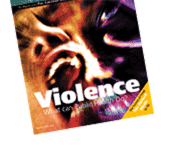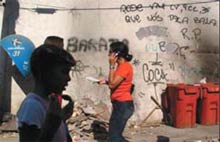
The Magazine of the Pan American Health Organization
Volume 8, Number 3, 2003


The Violence Pandemic
How Public Health Can Help Bring it Under Control
by Donna Eberwine
Violence has been with us since the beginning of humanity. But public health advocates argue it is in large part a preventable problem.

José Alfredo Padilha, 38, a Brazilian surgeon specializing in emergency medicine, has seen hundreds of victims of firearms violence during his 10 years at Rio de Janeiro’s Sousa Aguiar hospital. But one case in particular haunts him. It was a 12-year-old boy from a Rio shantytown who was caught in crossfire between police and members of a local gang. The boy arrived at the emergency room in his mother's arms, bleeding profusely from a gaping shotgun wound in his lower face.
"You could see the panic in his eyes," recalls Padilha. "It reflected his own pain and fear but also the shock of all of us around him. He never really realized the extent of his trauma because he never saw himself in the mirror."

Padilha's 12-year-old patient was one of the lucky ones. He had a slow recovery that involved several rounds of plastic surgery, but he eventually healed and went back home to his mother. Many of the victims of gun violence who come into Sousa Aguiar are dead on arrival, and many others go straight from the crime scene to the morgue.
"We see some 900 firearm injuries at my hospital every year," says Padilha. "That's nearly three a day, more than in a conflict zone like Gaza. And that's only a small part of the total picture of violence in Rio and Brazil."
With an average of seven firearms deaths daily (according to 2000 data), Rio de Janeiro has among the highest homicide rates in the world. But it is by no means alone in facing a crisis of violence. Violence has become one of the leading causes of death throughout Brazil, as well as in other countries of the Americas and other regions of the world. Globally, nearly 4,400 people per day died as a result of violence in 2000. And rates of violence appear to be increasing in most places where it is high.

Many would argue that violence is an inevitable part of the human condition, but public health advocates challenge that view.
"Violence is a preventable problem," says Etienne Krug, director of the violence and injury prevention program at the World Health Organization (WHO). "It is amenable to the tools we use to address all public health problems, and we need to start using them more than we have already to address the problem."
To rally a growing public health response to violence, Krug and a team of experts from around the world produced the World Report on Violence and Health in 2002 as the first global survey of its kind. It reports that an estimated 1.6 million people worldwide died as a result of violence in 2000. That is fewer than the 3 million deaths due to AIDS but greater than the 1.3 million deaths from traffic accidents during the same year.
The panorama of global violence presented in the report is at odds with some commonly held assumptions. Of all violent deaths in 2000, nearly half were suicides, just under a third were homicides and only a fifth were directly related to war. "This is quite different from the picture we get from the media, where the focus is on organized forms of violence," says Krug. "Suicides and homicides represent a much bigger proportion of fatal violence around the world."

The global report also shows that patterns of violence vary across regions and countries. The vast majority of violent deaths occur in low- to middle-income countries, with rates per 100,000 double those of high-income countries. In most regions, suicides outnumber homicides-in Europe, for example, by more than 2 to 1 and in the Western Pacific by as much as 7 to 1. By contrast, in both Africa and the Americas, there are nearly three homicides for every suicide. The countries of the former Soviet Union hold the record for the highest rates of both types of violent death.
Data show other important differences. Rates of violent death are much higher for men than women in every part of the world. More than threequarters of all deaths from violence in 2000 were of men, with males aged 15 to 29 being the hardest-hit. In a number of countries, violence is the leading cause of death for men in this group.
The tragic effects of violence go beyond victims and their families. In the United States, "every day we lose four children and 10 young adults to suicide and homicide," says Suzanne Binder, director of the National Center for Injury Prevention and Control at the U.S. Centers for Disease Control and Prevention (CDC). "Besides being tremendous personal losses for people who love them, these deaths represent huge loss of potential for our country. They're our youth, our workers."
More than deaths
When it comes to the impact of violence on health, "deaths are only the tip of the iceberg," says Krug. "These are the ones that are portrayed in the media, the ones that are slightly easier to count. But this is only a very small part" of the total burden of violence.
For every death there are many more injuries due to physical and sexual assaults. Yet data on these are harder to come by because fewer countries have good surveillance in this area.
"A large amount of violence does not get reported systematically but needs to be found out through specifically designed surveys," Krug says. "In those surveys, we find some of the most shocking numbers in our report."
Based on studies of nonfatal violence from more than 50 countries, the World Report on Violence and Health found that the proportion of women who say they have been victims of domestic violence varies from 10 percent in Paraguay and the Philippines to 22 percent in the United States, 30 percent in Canada, Antigua and Barbados, and 58 percent in Turkey.
"In some countries, up to 20 percent of women say they were sexually abused as a child, and up to 10 percent of men," says Krug. "In some countries, up to 40 percent of women say their first sexual intercourse was forced, and up to 30 percent of men say the same. In a few countries where studies exist on elderly abuse, 5 percent of the elderly say they have been abused in their home by the person who is supposed to take care of them. These numbers are enormous—much bigger than this tip of the iceberg that is mortality."

Beyond the immediate and direct effects of violence are its secondary consequences, which are even harder to measure. Experts on violence against women, for example, say it takes a far greater indirect than direct toll.
"The psychological consequences of violence against women are often more devastating and longer term than the physical ones," says Elsa Gómez, head of the Gender and Health Unit at the Pan American Health Organization (PAHO). "There is evidence that violence is partly responsible for higher rates of depression in women, and it clearly affects reproductive health. Children also suffer the consequences in their mother's womb or during childhood. Much of the effect is on mental health."
The economic costs of violence are among the most difficult impacts to measure. "What does violence cost in terms of lost productivity and economic development? What is the price of lost quality of life, for example, if we cannot walk around in the evening safely? All of these costs have never really been calculated for most countries," says Krug.

More research in these areas is needed to fill in the gaps and point the way toward public health actions that can reduce and prevent violence, public health advocates say. "It's only when we start putting up dollar signs that we can really get decision-makers more actively involved," says Krug. "We need not only to describe the vast amount of human suffering due to violence but also to point to the enormous financial losses that could be avoided through adequate prevention."
Public health research on violence has already begun to address the issues of what causes violence and what kinds of action might be taken to prevent it. Among the questions studies have examined are: What makes individuals behave violently? What are the environmental influences on this behavior? What are the community and societal influences? What are the key risk factors?

"The causes and risk factors of violence are very complex," says Alberto Concha-Eastman, PAHO regional advisor on violence and injury prevention. "There are influences on many levels: biological, psychological, behavioral and social factors."
Looking at biological influences, a 1991 study in Denmark found that 80 percent of youths arrested for violent offenses scored in the high range for delivery complications during birth. A 1993 U.S. study found that delivery complications predicted future violence when a parent had a history of mental illness. Other studies have found that low heart rates, particularly in boys, are associated with sensation-seeking and risk-taking behavior, while high heart rates are linked more to anxiety, fear and inhibitions. Other studies suggest that nervousness and anxiety are negatively related to violence.
More research has been produced on family and social influences. "We know that being a young male, under specific social and family conditions, is a risk factor for committing acts of violence," says Concha-Eastman. "Having witnessed or experienced abuse as a child is a risk factor for perpetrating violence later in life. Abuse of alcohol is another risk factor. We know that children who grow up in families with poor parenting practices, no supervision, where there is marital conflict, they are at greater risk of committing violence and of being victims of violence themselves. Individuals who grow up with lots of peers involved in violence and crime, this too is a risk for committing violence. Lack of schooling and poor work opportunities are major social factors that lead to involvement in violence."

Research also shows that living in a community with high levels of poverty, unemployment and drug trade activity is a risk factor, as is living in a society with high levels of gender or income inequality or social norms that tolerate or support violence.
Rodrigo Guerrero, former mayor of Cali, Colombia, and a public health expert by profession, relates current high levels of violence in his country with the legacy of political violence during the 1940s and 1950s. "The problem in Colombia is that a large part of society learned to resolve conflicts through violent methods—from crimes of passion to someone who kills his neighbor because he is too noisy," Guerrero says.
Research shows that the availability of means to commit violence, such as accessible handguns or pesticides for committing suicide, is another risk factor, along with weak police forces and criminal justice systems.
Proven responses
The growing concern about violence has produced not only research but also efforts around the world to address its causes and risks. "There is not a single country where there are no violence prevention efforts," says Krug. "The vast majority of programs unfortunately have not been evaluated. From those that have been, we know that it is possible to act on individuals, families, communities and societies to address the causes and really prevent violence."

Proven public health responses to violence include efforts to promote anger management, such as preschool enrichment programs that teach young children that violence is not the only response to stress, Krug says. Programs that work with children who are victims of family violence can help prevent them from becoming adults who perpetrate violence themselves. Programs to improve parenting skills in high-risk families have also shown success in some settings.
The "healthy communities" approach, which promotes improvements such as better outdoor lighting, more parks and recreation centers, and organized activities for youth, has also been effective in some settings. Efforts at the societal level include strengthening police and judicial systems, reducing poverty and inequality (both gender and income), improving education and controlling access to guns and other tools of violence.
In suicide prevention, efforts to restrict access to lethal means have shown some striking results. In Samoa, suicide rates declined dramatically in the 1980s when the poisonous pesticide paraquat began to be tightly controlled. In England, the removal of carbon monoxide from domestic gas and car exhaust in the 1960s helped lower that country's suicide rates.
"Many programs have shown success, and it's a question now of learning lessons from them and implementing and evaluating them in different settings," says Krug. "Public health can do more, contributing in all these areas where we can be helpful. We have first access to victims in emergency departments and morgues, for example, where we can collect information on the problem. We can contribute to research and to prevention, just as we do for many other public health problems. We can do more to encourage policy-making and informed decision-making in this area."
But tackling violence cannot be left to the public health community alone. Because its causes are so complex and varied, effective action to reduce violence must come from many sectors and many levels. The WHO report makes nine recommendations for effective action to reduce violence:
"Perhaps the most important of these is number four, promoting primary prevention responses," says Krug. "Too often the response to violence is putting more police in the streets. That probably helps for some types of violence, but it does very little to prevent child abuse, elderly abuse, violence against women in the family, or suicidal behavior. We need to complement that by acting on the root causes of violence. This is public health's first duty."
Donna Eberwine is editor of Perspectives in Health.